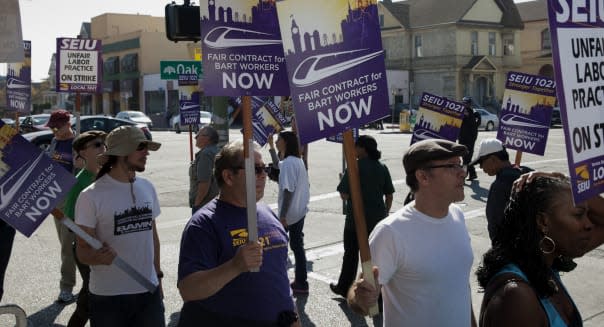BART Workers Won: Will Your City's Employees Strike Next?

Following almost four days of closures, Bay Area Rapid Transit trains started operating again Tuesday morning, after representatives for striking BART union workers reached a tentative deal with BART management on Monday night. And although both sides still must formally approve the agreement, workers appear to have won a 15.38 percent raise over their four-year contract, in exchange for concessions that include an increase in their monthly medical insurance premiums of about $50, and agreeing to start contributing a portion of their pension costs.
The BART strike is just the latest example of clashes between state and local government employees and the cash-strapped cities, counties, and states that employ them.
Newly energized by what many will see as a win, government workers around the country might well follow suit in efforts to defend themselves against a rising tide of municipal bankruptcies and other financial threats to their security.
Cities Under Siege
Just 90 minutes east of San Francisco, the city of Stockton, Calif., is just one of many local governments dealing with huge financial problems. Last year, Stockton became the largest city in the U.S. to file for bankruptcy, holding that dubious honor until July 2013, when Detroit took the crown.
In Stockton, current and retired city workers have found themselves at the forefront of controversy over the rights of government employees. The city has trimmed its workforce by about 30 percent, with dramatic reductions even to essential services such as its police department.
However, Stockton's proposed bankruptcy plan last month included full payments to the California Public Employees' Retirement System, thus pitting pension recipients against municipal bond investors and insurance companies, as well as other creditors of the city.
Not so say those retirees will get off unscathed: Health benefits promised to former city employees will be affected by the bankruptcy. But some say that even with that concession, the plan unfairly favors former workers at the expense of both current workers and other interested parties.
Showdown in Motown
Meanwhile, in Detroit, officials have laid even more of the blame for the city's financial troubles at the feet of former government employees.
%VIRTUAL-article-sponsoredlinks%A report last month from The New York Times showed that retired city workers actually received billions of dollars in extra pension payments. Even some current employees received supplemental income, and families of deceased workers sometimes received cash payments according to the report. Outside analysis by actuarial experts found that these excess payments to workers, retirees, and their families cost Detroit almost $2 billion between 1985 and 2008.
More broadly, state and local governments clearly benefited from the strong economies of the 1990s and mid-2000s, with investment gains bolstering pension plans and rising property values bringing in more tax revenue. Yet home prices and the stock market both plunged in the late 2000s, and that eliminated any financial cushion that state and local governments enjoyed prior to the Great Recession.
More Struggles to Come
As governments and government workers draw battle lines in their respective states, cities, and towns, many are waiting for the next shoe to drop.
Harrisburg, Pa., tried to file for bankruptcy protection, but its request was denied. Pennsylvania's insolvent capital city continues to work on its finances through a receivership proceeding; the latest proposal to lift it out of the hole involves leasing out its parking system and selling a power plant that converts waste to energy.
In California, Fresno has faced credit-rating downgrades that cite its weak finances after expansion plans that didn't pan out as well as local officials had hoped.
The Philadelphia School District had to borrow $50 million just to open its schools on time this year, and with a deficit of more than $300 million in its $2.35 billion budget, the district hopes to get workers to agree to cuts in pay and benefits under their labor contracts in order to close the gap.
Still, the pressure on governments to find ways to keep essential services running is immense. As a result, it's easier for government officials to make decisions that are geared more toward short-term patches rather than long-term solutions.
In the wake of the BART strike, more state and local government employees might recognize the leverage they have, only increasing the difficulty that government entities face in balancing the needs of their constituents against the limited financial resources of their taxpayers. Your city might well be the next to see government employees take action to defend themselves against the next swing of the budget ax.
You can follow Motley Fool contributor Dan Caplinger on Twitter @DanCaplinger or on Google+.

